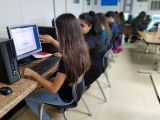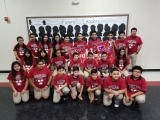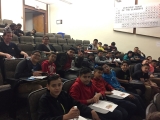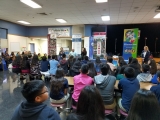-
Category 2
Selected in 2017
-
Grades: 6 - 8
School Setting: urban
Town Population: 60,000,000
Student Enrollment: 267
Student Demographics:
Black/African American: 0%
Teacher/Student Ratio: 1:25
White/Caucasian: 1.5%
Hispanic: 95.1%
Hawaiian/Pacific Islander: 0%
Asian: 3.4%
Native American: 0%
Other: 0%
% Reduced Lunch: 100%
% ELL Learners: 7.5%
Founded: 1995 -
PRINCIPAL:
Jose Covarrubia -
CONTACT:
4528 Leeland Street
Houston, TX 77023
713-924-1700
jcovarru@houstonisd.org
Project Chrysalis Middle School
Houston, TX
We have a strong belief that everyone must give back and we live by the philosophy that "To those whom much is given, much is expected".
- Describe specific programs in place to ensure that families are involved in the success of your school and students.
-
Project Chrysalis has one of the most at-risk student populations, yet the campus strives to build a strong home-school connection.
One of the initiatives is to provide a free breakfast to each child at school. The goals of the Free Breakfast Program are twofold- increase student attendance and ensure that every child has a nutritious meal to prepare him/her for learning throughout the school day. The underlying benefits include parents bringing their children to school on time, and the parents having a chance to informally interact with adults who speak the same language.
Due to the large number of Spanish speaking parents, all written communication is provided in Spanish and English. This helps the parents gain clarity and understanding about what their children are doing in school. It also brings a stronger sense of safety and well being when the parents know that they will be able to reach an adult in a timely manner who will understand and help them with their concerns. - Describe the most successful activity your school has initiated to strengthen ties to your community.
-
At Project Chrysalis there is a strong belief that everyone must give back and we live by the philosophy that "To those whom much is given, much is expected". Based on this philosophy of service, every parent and student at Project Chrysalis must volunteer at least 8 hours per semester and all service hours documentation must be submitted by the 3rd of May of each school year. A mid-year check is completed prior to the Winter Break in order to assure that all parents and students are on target for completing their volunteer service.
Having this requirement at Project Chrysalis allows parents to be more involved and share in the educational experience of their children. It also supports parents as they too can engage in professional development activities through our Communities in Schools Program.
- Describe your philosophy of school change or improvement.
-
The philosophy of change at Project Chrysalis is one coaching each another in order to meet the academic and school goals that have been set each school year. For example; the 15 person faculty at Project Chrysalis regularly lead sessions for first and second year teachers. During these sessions, new teachers are provided hands-on interactive professional development centered on research-based instructional strategies and best practices. New teachers naturally form cohorts and have opportunities to network, share and be observed by others.
The Project Chrysalis staff also lead cohorts for developing teachers. These individuals are teachers who are still honing in on refining their instructional practices. They have typically identified a focus area to strengthen and improve. The Project Chrysalis team enjoys sharing their experiences with creating end of the year exams and unit assessments. The faculty models data interpretation, how to create open ended responses and higher level questioning. - What are your school’s top two goals for the next year?
-
Project Chrysalis faculty and staff voted for specific goals for the 2017-2018 school year. The two main goals are in the content areas of reading and writing.
Goal: By the end of the 2017-2018 school year students in grades 6-8 will increase their Reading Approaches Level from 95% to 100% and writing from 96% to 100% and increase the Master's Level in reading from 33% to 50% and writing from 33% to 50%.
In order to meet these two goals the faculty will administer the Renaissance Universal Screener, analyze the data and create personalized instructional support to those students that are in need of support. - What is the single most important factor in the success of your school that others could replicate?
- Being a "Data Driven Campus" and making instructional decisions based on the data is what drives all of our activities. At Project Chrysalis, teachers understand that the mere collection of data cannot impact instruction unless time is taken to reflect on student results in a strategic, concrete way. Consequently, teachers complete a five-step data reflection, which empowers them to examine and interpret the data more effectively. First and foremost, instructors categorize the students based on overall mastery level, which then identifies students who are proficient, almost proficient, or struggling. As a result, tutorial sessions and partner pairs can be arranged based on data, and not more instinct alone. Afterwards, teachers characterize specific objectives from the unit as strengths and weaknesses, dependent upon quantitative results. This leads to teachers revisiting their long-term goals for the year.
- Describe the program or initiative that has had the greatest positive effect on student achievement, including closing achievement or opportunity gaps, if applicable.
-
At Project Chrysalis there is a belief that effective planning leads to high impact lessons and greater student achievement. This mentality has the greatest impact on student achievement and in closing the achievement gap.
Project Chrysalis teachers dedicate time during the summer to align state TEKS with the district scope and sequence for each content area. Student achievement data is analyzed and utilized to modify the curriculum so that it best fits the students who are being taught during a particular school year. This strategic plan guarantees that all of the required skills are being taught, the curriculum is being enriched, and that rigor and relevance are applied to student learning. It also fosters added academic value of more than one year and prepares students with Career and College Readiness Skills. - Explain how Title I funds are used to support your improvement efforts.
- The Title I funds at Project Chrysalis are utilized to support the instructional program. Mainly, the funds pay for the extra instructional support that the teachers give the students before school, after school and on Saturdays. If students were not given the extra support and teachers were not given the extra pay, the learning gaps would not narrow and students would be at an academic disadvantage when entering high school. The faculty and staff strongly believe that this cannot happen and are willing to devote additional instructional time with those students that need the extra academic support.
- Identify the critical professional development activities you use to improve teaching and student learning.
-
In order for any school to substantially further its progress and maximize the potential of its human capital, teachers must attend on-going professional development. Project Chrysalis fully recognizes such a philosophy and embraces it. Staff members not only respond favorably and constructively to district-wide initiatives through collegial participation on campus, but they also actively seek professional development classes and seminars at the local and state levels knowing that acquiring new strategies will bolster student achievement.
Moreover, certifications are updated on a yearly basis. Instructors have the opportunity to continuously improve their practice by attending content specific seminars from the College Board, Laying the Foundations Organization, the Rice Summer Institute, and other eminent organizations. These sessions offer faculty invaluable insight concerning the skills, content, and assessments awaiting middle school students in high school and beyond. - Describe how data is used to improve student achievement and inform decision making.
- As a campus, Project Chrysalis believes that a commitment to data collection and analysis is paramount in terms of adjusting instruction, pacing and curricula in order to meet student needs. At the onset of every academic year, teachers in all content areas administer diagnostic assessments in order to gauge student readiness levels concerning key objectives. Teachers focus their assessments on readiness standards, as well as the most important objectives from previous and future grade levels. Afterwards, teachers utilize this data to modify their unit and long-term plans accordingly. Specific weaknesses are targeted for the upcoming unit, while strengths can be harnessed and utilized as key levers in the future. This process of data reflection not only allows teachers to identify potential areas of improvement, but also enables instructors to recognize current strengths within the student population that further assist in the mastery of additional objectives.
- Describe your school culture and explain changes you’ve taken to improve it.
-
The culture at Project Chrysalis is one of collegiality, support and a "Kids First" attitude. It is a campus where everyone is part of the leadership team and everyone plays an integral role in the success of the students. Every faculty member is a life line to the student in need, regardless of the issue, the day of the week or the time of day. It is not uncommon for faculty members to share their home telephone numbers and it is not uncommon for students to be speaking with their teachers throughout the evening about classroom assignments.
The culture is spread and supported by the principal and assistant principal who consistently focus on the students. Every decision that is made at the campus level is made based on what is in the best interest of the students. Everyone understands and accepts that some decisions may not be "popular" and that these decisions are not to be taken personally but rather from a neutral perspective which puts the students' best interest first. Simply put the administrators' philosophy of instruction is that effective instruction determines the educational life and death of children.
Stats
-
Category 2
Selected in 2017
-
Grades: 6 - 8
School Setting: urban
Town Population: 60,000,000
Student Enrollment: 267
Student Demographics:
Black/African American: 0%
Teacher/Student Ratio: 1:25
White/Caucasian: 1.5%
Hispanic: 95.1%
Hawaiian/Pacific Islander: 0%
Asian: 3.4%
Native American: 0%
Other: 0%
% Reduced Lunch: 100%
% ELL Learners: 7.5%
Founded: 1995 -
PRINCIPAL:
Jose Covarrubia -
CONTACT:
4528 Leeland Street
Houston, TX 77023
713-924-1700
jcovarru@houstonisd.org










